Revitalizing the Biochemical Soil Properties of Degraded Coastal Soil Using Prosopis juliflora Biochar
Abstract
:1. Introduction
2. Materials and Methods
2.1. Study Area
2.2. Experimental Design
2.3. Soil Sampling and Analysis
2.3.1. Soil Sampling
2.3.2. Determination of Soil Chemical Properties
2.3.3. Determination of Microbial Population (Bacteria and Fungi)
2.3.4. Baseline Status
2.4. Statistical Analysis
3. Results and Discussion
3.1. Effect of Biochar Application on Biochemical Soil Properties
3.1.1. Soil pH
3.1.2. Total Nitrogen
3.1.3. Soil Total Organic Carbon (TOC)
3.1.4. Available Phosphorus
3.1.5. Extractable Potassium
3.1.6. Cation Exchange Capacity (CEC)
3.2. Effect of Biochar on Soil Microbial Population
4. Conclusions
Author Contributions
Funding
Institutional Review Board Statement
Informed Consent Statement
Data Availability Statement
Conflicts of Interest
References
- Vanlauwe, B.; AbdelGadir, A.H.; Adewopo, J.; Adjei-Nsiah, S.; Ampadu-Boakye, T.; Asare, R.; Baijukya, F.; Baars, E.; Bekunda, M.; Coyne, D.; et al. Looking back and moving forward: 50 years of soil and soil fertility management research in sub-Saharan Africa. Int. J. Agric. Sustain 2017, 15, 613–631. [Google Scholar] [CrossRef] [PubMed]
- Nungula, E.Z.; Mugwe, J.; Nasar, J.; Massawe, H.J.; Karuma, A.N.; Maitra, S.; Seleiman, M.F.; Dindaroglu, T.; Khan, N.; Gitari, H.I. Land degradation unmasked as the key constraint in sunflower (Helianthus annus) production: Role of GIS in Revitalizing this vital sector. Cogent Food Agric. 2023, 9, 2267863. [Google Scholar] [CrossRef]
- Nyawade, S.; Gitari, H.I.; Karanja, N.N.; Gachene, C.K.K.; Schulte-Geldermann, E.; Sharma, K.; Parker, M.L. Enhancing climate resilience of rain-fed potato through legume intercropping and silicon application. Front. Sustain. Food Sys. 2020, 4, 566345. [Google Scholar] [CrossRef]
- Kisaka, M.O.; Shisanya, C.; Cournac, L.; Manlay, J.R.; Gitari, H.; Muriuki, J. Integrating no-tillage with agroforestry augments soil quality indicators in Kenya’s dry-land agroecosystems. Soil Tillage Res. 2023, 227, 105586. [Google Scholar] [CrossRef]
- Raza, M.A.; Zhiqi, W.; Yasin, H.S.; Gul, H.; Qin, R.; Rehman, S.U.; Mahmood, A.; Iqbal, Z.; Ahmed, Z.; Luo, S.; et al. Effect of crop combination on yield performance, nutrient uptake, and land use advantage of cereal/legume intercropping systems. Field Crops Res. 2023, 304, 109144. [Google Scholar] [CrossRef]
- Obalum, S.E.; Buri, M.M.; Nwite, J.C.; Watanabe, H.Y.; Igwe, C.A.; Wakatsuki, T. Soil degradation-induced decline in productivity of Sub-saharan African soils: The prospects of looking downwards the lowlands with the sawah ecotechnology. App. Environ. Soil Sci. 2012, 2012, 673926. [Google Scholar] [CrossRef]
- Bashagaluke, J.B.; Logah, V.; Opoku, A.; Sarkodie-Addo, J.; Quansah, C. Soil nutrient loss through erosion: Impact of different cropping systems and soil amendments in Ghana. PLoS ONE 2018, 13, e0208250. [Google Scholar] [CrossRef] [PubMed]
- De Melo Carvalho, M.T.; Madari, B.E.; Bastiaans, L.; van Oort, P.A.J.; Heinemann, A.B.; da Silva, M.A.S.; de Holanda, A.; Maia, N.; Meinke, H. Biochar improves fertility of a clay soil in the Brazilian Savannah: Short term effects and impact on rice yield. J. Agric. Rural Dev. Trop. Subtrop. 2013, 114, 101–107. [Google Scholar]
- Joseph, S.D.; Camps-Arbestain, M.; Lin, Y.; Munroe, P.; Chia, C.H.; Hook, J.; van Zwieten, L.; Kimber, S.; Cowie, A.; Singh, B.P.; et al. An investigation into the reactions of biochar in soil. Aust. J. Soil Res. 2010, 48, 501–515. [Google Scholar] [CrossRef]
- Oshunsanya, S.O.; Aliku, O.O. Biochar Technology for Sustainable Organic Farming. In Organic Farming—A Promising Way of Food Production; InTech: Houston, TX, USA, 2016. [Google Scholar] [CrossRef]
- Liu, Z.; Dugan, B.; Masiello, C.A.; Gonnermann, H.M. Biochar particle size, shape, and porosity act together to influence soil water properties. PLoS ONE 2017, 12, e0179079. [Google Scholar] [CrossRef]
- Lane, J. An Overview of Current Biochar and Activated Carbon Markets; McLaughlin H Lee Enterprise Consulting Inc.: Sherwood, AR, USA, 2016; Available online: https://advancedbiofuelsusa.info/an-overview-of-the-current-biochar-and-activated-carbon-markets/ (accessed on 12 March 2022).
- Adeyemi, T.O.A.; Idowu, O.D. Biochar: Promoting Crop Yield, Improving Soil Fertility, Mitigating Climate Change and Restoring Polluted Soils. World News Nat. Sci. 2017, 8, 25–36. Available online: www.worldnewsnaturalsciences.com (accessed on 1 August 2023).
- Shao, Z.; Mwakidoshi, E.R.; Muindi, E.M.; Soratto, R.P.; Ranjan, S.; Padhan, S.R.; Wamukota, A.W.; Sow, S.; Wasonga, D.O.; Nasar, J.; et al. Synthetic fertilizer application coupled with bioslurry optimizes potato (Solanum tuberosum) growth and yield. Agronomy 2023, 13, 2162. [Google Scholar] [CrossRef]
- Olsen, S.R.; Sommers, L.E. Phosphorus. In Methods of Soil Analysis: Part 2. Chemical and Microbiological Properties, 2nd ed.; Page, A.L., Ed.; ASA and SSSA: Madison, WI, USA, 1982; Volume 9, pp. 403–430. [Google Scholar]
- Pühringer, H. Effects of Different Biochar Application Rates on Soil Fertility and Soil Water Retention in On-Farm Experiments on Smallholder Farms in Kenya. 2016. Available online: http://stud.epsilon.slu.se (accessed on 12 March 2022).
- Xie, T.; Sadasivam, B.Y.; Asce, S.M.; Reddy, K.R.; Asce, F.; Wang, C.; Spokas, K. Review of the Effects of Biochar Amendment on Soil Properties and Carbon Sequestration; ASCE: Reston, VA, USA, 2015. [Google Scholar] [CrossRef]
- Berek, A.K.; Hue, N.; Ahmad, A. Exploring the potential roles of biochars on land degradation mitigation. J. Degrad. Min. Lands Manag. 2014, 1, 149–158. [Google Scholar]
- Mwadalu, R.; Mochoge, B.; Mwangi, M.; Maitra, S.; Gitari, H. Response of Gadam sorghum (Sorghum bicolor) to farmyard manure and inorganic fertilizer application. Int. J. Agric. Environ. Biotechnol. 2022, 15, 51–60. [Google Scholar] [CrossRef]
- Mohan, D.; Abhishek, K.; Sarswat, A.; Patel, M.; Singh, P.; Pittman, C.U. Biochar production and applications in soil fertility and carbon sequestration-a sustainable solution to crop-residue burning in India. RSC Adv. 2018, 8, 508–520. [Google Scholar] [CrossRef]
- Hailegnaw, N.S.; Mercl, F.; Pračke, K.; Praus, L.; Száková, J.; Tlustoš, P. The role of biochar and soil properties in determining the available content of Al, Cu, Zn, Mn, and Cd in soil. Agronomy 2020, 10, 885. [Google Scholar] [CrossRef]
- Zheng, Y.; Han, X.; Li, Y.; Yang, J.; Li, N.; An, N. Effects of Biochar and Straw Application on the Physicochemical and Biological Properties of Paddy Soils in Northeast China. Sci. Rep. 2019, 9, 16531. [Google Scholar] [CrossRef] [PubMed]
- Gwenzi, W.; Chaukura, N.; Mukome, F.N.D.; Machado, S.; Nyamasoka, B. Biochar production and applications in sub-Saharan Africa: Opportunities, constraints, risks and uncertainties. J. Envion. Manag. 2015, 150, 250–261. [Google Scholar] [CrossRef]
- Mensah, A.K.; Frimpong, K.A. Biochar and/or Compost Applications Improve Soil Properties, Growth, and Yield of Maize Grown in Acidic Rainforest and Coastal Savannah Soils in Ghana. Int. J. Agron. 2018, 2018, 6837404. [Google Scholar] [CrossRef]
- Ding, Y.; Liu, Y.; Liu, S.; Li, Z.; Tan, X.; Huang, X.; Zeng, G.; Zhou, L.; Zheng, B. Biochar to improve soil fertility. A review. Agron. Sustain. Dev. 2016, 36, 36. [Google Scholar] [CrossRef]
- Gao, L.; Wang, R.; Shen, G.; Zhang, J.; Meng, G.; Zhang, J. Effects of biochar on nutrients and the microbial community structure of tobacco-planting soils. J. Soil Sci. Plant Nut. 2017, 17, 884–896. [Google Scholar] [CrossRef]
- Truong, T.H.H.; Marschner, P. Addition of residues with different C/N ratio in soil over time individually or as mixes-effect on nutrient availability and microbial biomass depends on amendment rate and frequency. J. Soil Sci. Plant Nut. 2018, 18, 1173–1186. [Google Scholar] [CrossRef]
- Bhattarai, A.; Bhattarai, B.; Pandey, S. Variation of soil microbial population in different soil horizons. J. Microbiol. Exp. 2015, 2, 75–78. [Google Scholar] [CrossRef]
- Mwadalu, R.U.; Mochoge, B.; Danga, B. Effects of biochar and manure on soil properties and growth of Casuarina equisetifolia seedlings at the coastal region of Kenya. Sci. Res. Essays 2020, 15, 52–63. [Google Scholar] [CrossRef]
- Shitanda, D.; Mukonyi, K.; Kagiri, M.; Gachua, M.; Simiyu, L. Properties of Prosopis juliflora and its potential uses in asals of Kenya. Jomo Kenyatta Univ. Agric. Technol. 2013, 15, 15–27. [Google Scholar]
- Zhang, M.; Liu, Y.; Wei, Q.; Gou, J. Biochar enhances the retention capacity of nitrogen fertilizer and affects the diversity of nitrifying functional microbial communities in karst soil of southwest China. Ecotoxicol. Environ. Saf. 2021, 226, 112819. [Google Scholar] [CrossRef] [PubMed]
- Choge, S.; Pasiecznik, N.; Harvey, M.; Wright, J.; Awan, S.; Harris, P. Prosopis pods as human food, with special reference to Kenya. Water SA 2007, 33, 6. [Google Scholar]
- Kenya, A. The Invasive Species Prosopis juliflora and Its Spread in Coastal Kenya. Available online: https://www.arocha.or.ke/wp-content/uploads/sites/16/2020/03/Report.pdf (accessed on 9 October 2023).
- Jena, J.; Maitra, S.; Hossain, A.; Pramanick, B.; Gitari, H.I.; Praharaj, S.; Shankar, T.; Palai, J.B.; Rathore, A.; Mandal, T.K.; et al. Role of Legumes in Cropping System for Soil Ecosystem Improvement. In Ecosystem Services: Types, Management and Benefits; Jatav, H.S., Ed.; Nova Science Publishers, Inc.: New York, NY, USA, 2022. [Google Scholar]
- Ravi, K.N.; Rameha, M.N.; Dupdal, R.; Vijayan, B.; Prabharatti, M.; Naik, B.S. Potential use of invasive Prosopis juliflora for biochar in semi-arid zones of Karnataka. Soil Water Bull. 2022, 7, 42–46. [Google Scholar]
- Sombroek, W.G.; Braun, H.M.H.; van der Pouw, B.J.A. Exploratory Soil Map and Agro-Climatic Zone Map of Kenya, 1980, Scale 1: 1,000,000. (Exploratory Soil Survey Report. Kenya Soil Survey; No. E1). 1982. Available online: https://edepot.wur.nl/399397 (accessed on 1 August 2023).
- Mbuvi, M.T.E.; Muchiri, M.N.; Wairungu, S.N. Modern silviculture practices versus livelihood needs: The case of Casuarina growing along the Kenyan Coastal Region. In Proceedings of the 4th International Conference: Improving Smallholder Livelihoods through Improved Casuarina Productivity, Haikou, China, 22–25 March 2010. [Google Scholar]
- Anderson, J.M.; Ingram, J.S.I. Tropical Soil Biology and Fertility: A Handbook of Methods. J. Ecol. 1993, 78, 547. [Google Scholar] [CrossRef]
- Okalebo, R.; Gathua, K.W.; Woomer, P.L. Laboratory Methods of Soil and Plant Analysis: A Working Manual, 2nd ed.; The Sustainable Agriculture Centre for Research Extension and Development in Africa: Bungoma, Kenya, 2002. [Google Scholar]
- NAAIAP (National Accelerated Agricultural Inputs Access Programme); KARI (Kenya Agricultural Research Institute). Soil Suitability Evaluation for Maize Production in Kenya; Ministry of Agriculture, Livestock and Fisheries: Nairobi, Kenya, 2014. Available online: https://www.kalro.org (accessed on 10 June 2022).
- Shetty, R.; Prakash, N.B. Effect of different biochars on acid soil and growth parameters of rice plants under aluminium toxicity. Sci. Rep. 2020, 10, 12249. [Google Scholar] [CrossRef]
- Trupiano, D.; Cocozza, C.; Baronti, S.; Amendola, C.; Vaccari, F.P.; Lustrato, G.; di Lonardo, S.; Fantasma, F.; Tognetti, R.; Scippa, G.S. The effects of biochar and its combination with compost on lettuce (Lactuca sativa L.) growth, soil properties, and soil microbial activity and abundance. Int. J. Agron. 2017, 2017, 3158207. [Google Scholar] [CrossRef]
- Geng, N.; Kang, X.; Yan, X.; Yin, N.; Wang, H.; Pan, H.; Yang, Q.; Lou, Y.; Zhuge, Y. Biochar mitigation of soil acidification and carbon sequestration is influenced by materials and temperature. Ecotoxicol. Environ. Saf. 2022, 232, 113241. [Google Scholar] [CrossRef] [PubMed]
- Zhang, M.; Riaz, M.; Zhang, L.; El-Desouki, Z.; Jiang, C. Biochar induces changes to basic soil properties and bacterial communities of different soils to varying degrees at 25 mm rainfall: More effective on acidic soils. Front. Microbiol. 2019, 10, 1321. [Google Scholar] [CrossRef] [PubMed]
- Dai, Z.; Wang, Y.; Muhammad, N.; Yu, X.; Xiao, K.; Meng, J.; Liu, X.; Xu, J.; Brookes, P.C. The Effects and Mechanisms of Soil Acidity Changes, following Incorporation of Biochars in Three Soils Differing in Initial pH. Soil Sci. Soc. Am. J. 2014, 78, 1606–1614. [Google Scholar] [CrossRef]
- Leghari, S.J.; Laghari, G.M.; Ahmed, T. Role of Nitrogen for Plant Growth and Development: A review Agronomical Study View Project Utilize Residual Nutrients for Crop View project. Adv. Environ. Biol. 2016, 10, 209–218. Available online: https://www.researchgate.net/publication/309704090 (accessed on 19 August 2023).
- Yunilasari, M.; Sufardi, Z. Effects of biochar and cow manure on soil chemical properties and peanut (Arachis hypogaea L.) yields in entisol. IOP Conf. Ser. Earth Environ. Sci. 2020, 425, 012014. [Google Scholar] [CrossRef]
- Hu, T.; Wei, J.; Du, L. The effect of biochar on nitrogen availability and bacterial community in farmland. Ann. Microbiol. 2023, 73, 4. [Google Scholar] [CrossRef]
- Syuhada, A.B.; Shamshuddin, J.; Fauziah, C.I.; Rosenani, A.B.; Arifin, A. Biochar as soil amendment: Impact on chemical properties and corn nutrient uptake in a Podzol. Can. J. Soil Sci. 2016, 96, 400–412. [Google Scholar] [CrossRef]
- Rawat, J.; Saxena, J.; Sanwal, P. Biochar: A Sustainable Approach for Improving Plant Growth and Soil Properties. 2019. Available online: www.intechopen.com (accessed on 15 August 2023).
- Agegnehu, G.; Bass, A.M.; Nelson, P.N.; Muirhead, B.; Wright, G.; Bird, M.I. Biochar and biochar-compost as soil amendments: Effects on peanut yield, soil properties and greenhouse gas emissions in tropical North Queensland, Australia. Agric. Ecosys. Environ. 2015, 213, 72–85. [Google Scholar] [CrossRef]
- Ghosh, S.; Ow, L.F.; Wilson, B. Influence of biochar and compost on soil properties and tree growth in a tropical urban environment. Int. J. Environ. Sci. Technol. 2015, 12, 1303–1310. [Google Scholar] [CrossRef]
- Phillips, C.L.; Meyer, K.M.; Garcia-Jaramillo, M. Towards predicting biochar impacts on plant-available soil nitrogen content. Biochar 2022, 4, 9. [Google Scholar] [CrossRef]
- Muthukumar, T.; Kathikeyan, A.; Udaiyan, K. Evaluation of Growth and Nutrient Uptake of Casuarina equisetifolia on Alfisol Soil Inoculated with Different Arbuscular Mycorrhizal Fundi. In Advances in Casuarina Research in India—Proceedings of the 2nd National Seminar on Casuarinas; IFGTB: Coimbatore, India, 2012. [Google Scholar]
- Abdullaeva, Y.; Dr, S.; Mankasingh, U. Biochar Effects on Fertility of Saline and Alkaline Soils (Navoiy Region, Uzbekistan); United Nations University Land Restoration Training Programme: Reykjavik, Iceland, 2014; Available online: http://www.unulrt.is/ (accessed on 20 August 2023).
- Ghorbani, M.; Neugschwandtner, R.W.; Soja, G.; Konvalina, P.; Kopecký, M. Carbon fixation and soil aggregation affected by biochar oxidized with hydrogen peroxide: Considering the efficiency of pyrolysis temperature. Sustainability 2023, 15, 7158. [Google Scholar] [CrossRef]
- Saletink, B.; Zagula, G.; Bojcar, M.; Tarapatskyy, M.; Bobula, G.; Puchalski, C. Biochar as a multifunctional component of environment: A review. App. Sci. 2019, 9, 1139. [Google Scholar] [CrossRef]
- Zhang, X.; Yang, X.; Yuan, X.; Tian, S.; Wang, X.; Zhang, H.; Han, L. Effect of pyrolysis temperature on composition, carbon fraction and abiotic stability of straw biochars: Correlation and quantitative analysis. Carbon Res. 2022, 1, 17. [Google Scholar] [CrossRef]
- Kalina, M.; Sovova, S.; Svec, J.; Trudicova, M.; Hajzler, J.; Kubikova, L.; Enev, V. The Effect of Pyrolysis Temperature and the Source Biomass on the Properties of Biochar Produced for the Agronomical Applications as the Soil Conditioner. Materials 2022, 12, 8855. [Google Scholar] [CrossRef] [PubMed]
- Lu, X.; Yin, Y.; Li, S.; Ma, H.; Gao, R.; Yin, Y. Effects of Biochar Feedstock and Pyrolysis Temperature on Soil Organic Matter Mineralization and Microbial Community Structures of Forest Soils. Front. Environ. Sci. 2021, 9, 717041. [Google Scholar] [CrossRef]
- Lawawiec, A.; Strassburg, B.B.N.; Juqueira, A.B.; Araujo, E.; de Moraes, L.F.D.; Pinto, H.A.; Castro, A.; Rangel, M.; Malaguti, G.A.; Rodrigues, A.F.; et al. Biochar amendment improves degraded pasturelands in Brazil: Environmental and cost-benefit analysis. Sci. Rep. 2019, 9, 11993. [Google Scholar] [CrossRef]
- Tisserant, A.; Cherubini, F. Potentials, Limitations, Co-Benefits, and Trade-Offs of Biochar Applications to Soils for Climate Change Mitigation. Land 2019, 2019, 179. [Google Scholar] [CrossRef]
- Srinivasarao, C.; Gopinath, K.A.; Venkatesh, G.; Dubey, A.K.; Wakudkar, H.; Purakayastha, T.J.; Pathak, H.; Jha, P.; Lakaria, B.L.; Rajkhowa, D.J.; et al. USE of Biochar for Soil Health Management and Greenhouse Gas Mitigation in India: Potential and Constraints; Central Research Institute for Dryland Agriculture: Hyderabad, India, 2013; 51p. [Google Scholar]
- Omulo, G. Biochar Potential in Improving Agricultural Production in East Africa. In Applications of Biochar for Environmental Safety; Abdelhafez, A.A., Abbas, M.H.H., Eds.; IntechOpen: Houston, TX, USA, 2020. [Google Scholar] [CrossRef]
- Wang, J.; Xiong, Z.; Kuzyakov, Y. Biochar stability in soil: Meta-analysis of decomposition and priming effects. GCB Bionergy 2016, 8, 512–523. [Google Scholar] [CrossRef]
- Fatima, S.; Riaz, M.; Al-Wabel, M.I.; Arif, M.S.; Yasmeen, T.; Hussain, Q.; Roohi, M.; Fahad, S.; Ali, K.; Arif, M. Higher biochar rate strongly reduced decomposition of soil organic matter to enhance C and N sequestration in nutrient-poor alkaline calcareous soil. J. Soils Sediments 2020, 21, 148–162. [Google Scholar] [CrossRef]
- Jiang, M.; Caibin, L.; Gao, W.; Cai, K.; Tang, Y.; Cheng, J. Comparison of long-term effects of biochar application on soil organic carbon and its fractions in two ecological sites in karst regions. Geoderma Reg. 2022, 28, e00477. [Google Scholar] [CrossRef]
- Parecido, R.J.; Soratto, R.P.; Perdoná, M.J.; Guidorizzi, F.V.C.; Gomes, G.G.; Paula, R.A. Limestone increased coffee yield and profitability more than phosphogypsum or their combination. Agron. J. 2021, 113, 3586–3599. [Google Scholar] [CrossRef]
- NRCS (Natural Resources Conservation Services). Soil Phosphorus, Soil Health Guide to Educators. 2014. Available online: https://cropwatch.unl.edu/documents/USDA_NRCS_phosphorus_guide.pdf (accessed on 27 August 2023).
- Jensen, T.L. Soil pH and the Availability of Plant Nutrients, IPNI Plant Nutrition Today, Fall 2010, No. 2. Available online: www.ipni.net/pnt (accessed on 19 August 2023).
- Glaser, B.; Lehr, V.I. Biochar effects on phosphorus availability in agricultural soils: A meta-analysis. Sci. Rep. 2019, 9, 9338. [Google Scholar] [CrossRef] [PubMed]
- Li, F.; Liang, X.; Niyungeko, C.; Sun, T.; Liu, F.; Arai, Y. Effects of biochar amendments on soil phosphorus transformation in agricultural soils. Adv. Agron. 2019, 158, 131–172. [Google Scholar] [CrossRef]
- Shen, Q.; Hedley, M.; Camps Arbestain, M.; Kirschbaum, M.U.F. Can biochar increase the bioavailability of phosphorus? J. Soil Sci. Plant Nut. 2016, 16. [Google Scholar] [CrossRef]
- Liao, D.; Zhang, C.; Li, H.; Lambers, H.; Zhang, F. Changes in soil phosphorus fractions following sole cropped and intercropped maize and faba bean grown on calcareous soil. Plant Soil 2020, 448, 587–601. [Google Scholar] [CrossRef]
- Aung, A.; Han, S.H.; Youn, W.; Meng, L.; Cho, M.S.; Park, B.B. Biochar effects on the seedling quality of Quercus serrata and Prunus sargentii in a containerized production system. For. Sci. Technol. 2018, 14, 112–118. [Google Scholar] [CrossRef]
- Dume, B.; Berecha, G.; Tulu, S. Characterization of biochar produced at different temperatures and its effect on acidic nitosol of Jimma, Southwest Ethiopia. Int. J. Soil Sci. 2015, 10, 63. [Google Scholar] [CrossRef]
- Miller, J.O. Soil pH Affects Nutrient Availability; Fact Sheet, FS-1054; University of Maryland: College Park, MD, USA, 2016; Available online: https://extension.umd.edu/ (accessed on 28 August 2023).
- Wang, L.; Xue, C.; Nie, X.; Liu, Y.; Chen, F. Effects of biochar application on soil potassium dynamics and crop uptake. J. Plant Nut Soil Sci. 2018, 181, 635–643. [Google Scholar] [CrossRef]
- Jien, S.H.; Wang, C.S. Effects of biochar on soil properties and erosion potential in a highly weathered soil. Catena 2013, 110, 225–233. [Google Scholar] [CrossRef]
- Kaur, V.; Sharma, P. Effect of Prosopis juliflora Biochar on Physico-Chemical Properties of Naphthalene and Phenanthrene Contaminated Soil. Polycyclic Aromatic Comp. 2021, 41, 1406–1417. [Google Scholar] [CrossRef]
- Weber, K.; Quicker, P. Properties of biochar. Fuel 2018, 217, 240–261. [Google Scholar] [CrossRef]
- Nyawade, S.O.; Karanja, N.N.; Gachene, C.K.K.; Gitari, H.I.; Schulte-Geldermann, E.; Parker, M.L. Short-term dynamics of soil organic matter fractions and microbial activity in smallholder legume intercropping systems. Appl. Soil Ecol. 2019, 142, 123–135. [Google Scholar] [CrossRef]
- Eyasu, E. Effect of Prosopis juliflora Biochar Amendment on Some Soil Properties: The Case of Salic Fluvisols from Melkawerer Research Station, Ethiopia. Ph.D. Thesis, Addis Ababa University, Addis Ababa, Ethiopia, 2018. [Google Scholar]
- Gul, S.; Whalen, J.K.; Thomas, B.W.; Sachdeva, V.; Deng, H. Physico-chemical properties and microbial responses in biochar-amended soil: Mechanisms and future directions. Agric. Ecosys. Environ. 2015, 206, 46–49. [Google Scholar] [CrossRef]
- Ullah, Z.; Ali, S.; Muhammad, N. Biochar impact on microbial population and elemental composition of red soil. Arab. J. Geosci. 2020, 13, 757. [Google Scholar] [CrossRef]
- Azeem, M.; Hale, L.; Montgomery, J.; Crowley, D.; McGiffen, M.E., Jr. Biochar and compost effects on soil microbial communities and nitrogen-induced respiration in turfgrass soils. PLoS ONE 2020, 15, e0242209. [Google Scholar] [CrossRef] [PubMed]
- Zhang, Q.Z.; Dijkstra, F.A.; Liu, X.R.; Wang, Y.D.; Huang, J.; Lu, N. Effects of biochar on soil microbial biomass after four years of consecutive application in the north China Plain. PLoS ONE 2014, 9, e102062. [Google Scholar] [CrossRef] [PubMed]
- Mekuria, W.; Noble, A. The role of biochar in ameliorating disturbed soils and sequestering soil carbon in tropical agricultural production systems. Appl. Environ. Soil Sci. 2013, 2013, 354965. [Google Scholar] [CrossRef]
- Zhao, Y.; Wang, X.; Yao, G.; Lin, Z.; Xu, L.; Jiang, Y.; Jin, Z.; Shan, S.; Ping, L. Advances in the Effects of Biochar on Microbial Ecological Function in Soil and Crop Quality. Sustainability 2022, 14, 10411. [Google Scholar] [CrossRef]
- Bonanomi, G.; Ippolito, F.; Cesarano, G.; Nanni, B.; Lombardi, N.; Rita, A.; Saracino, A.; Scala, F. Biochar as plant growth promoter: Better off alone or mixed with organic amendments? Front. Plant Sci. 2017, 8, 1570. [Google Scholar] [CrossRef]

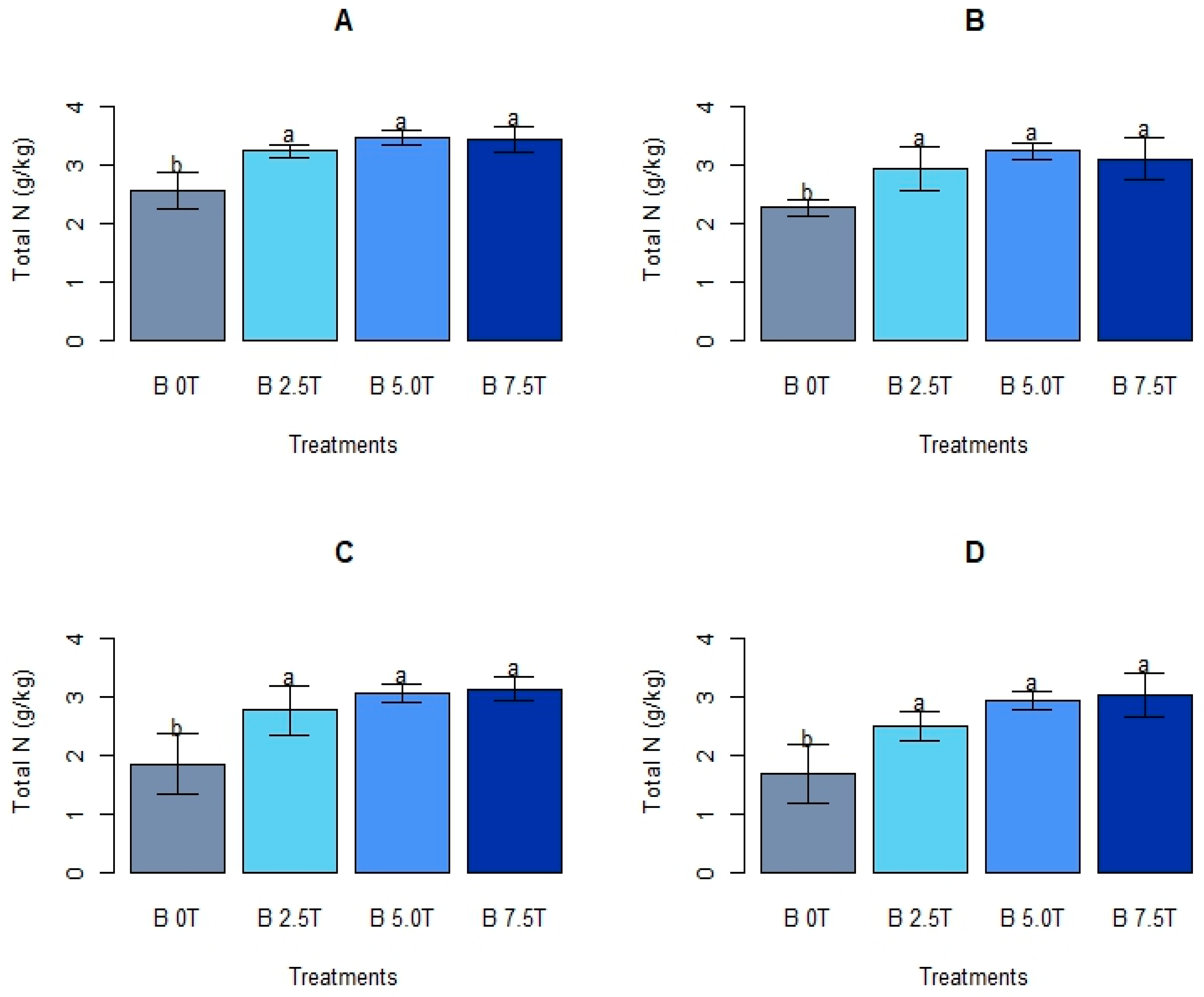

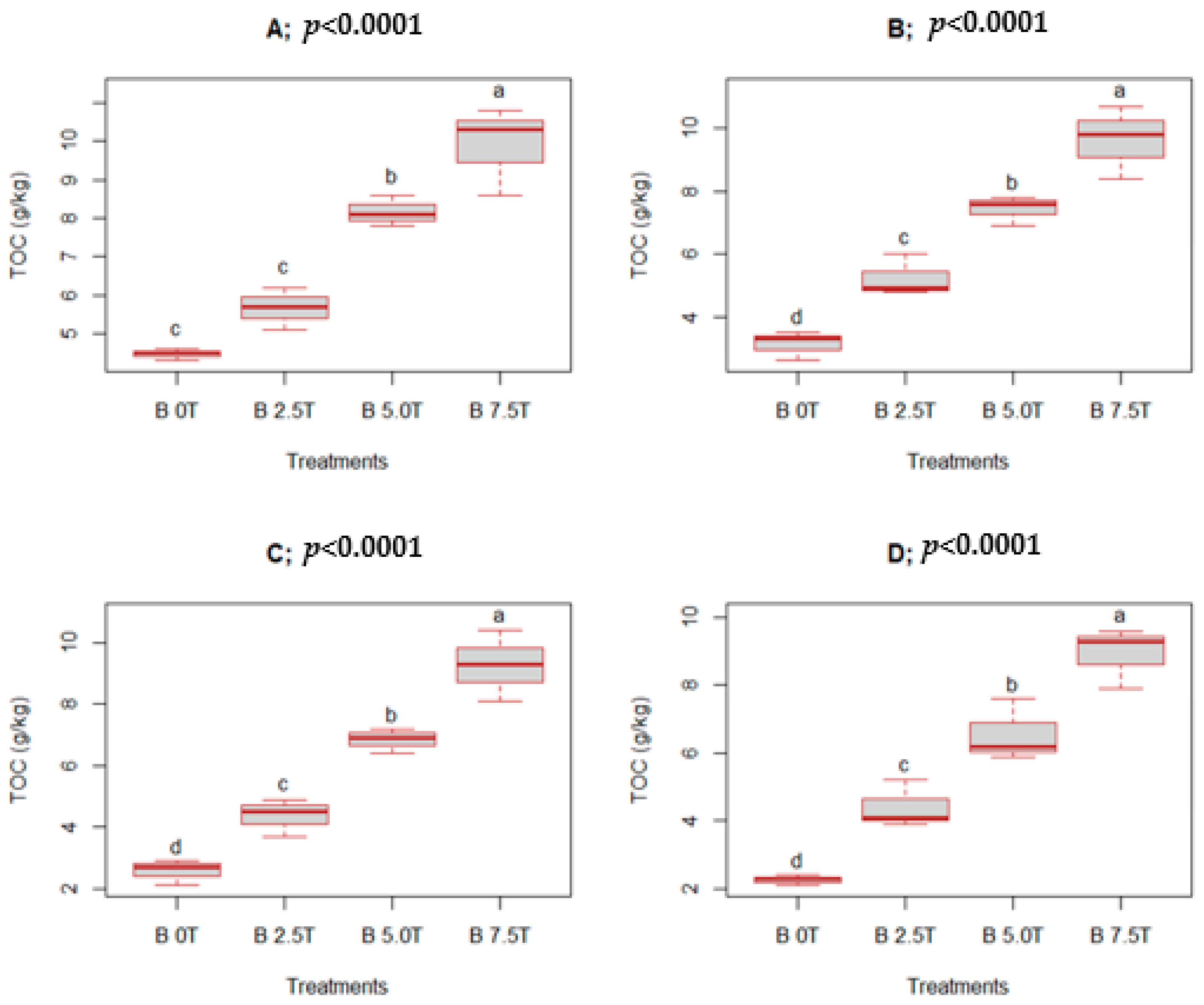

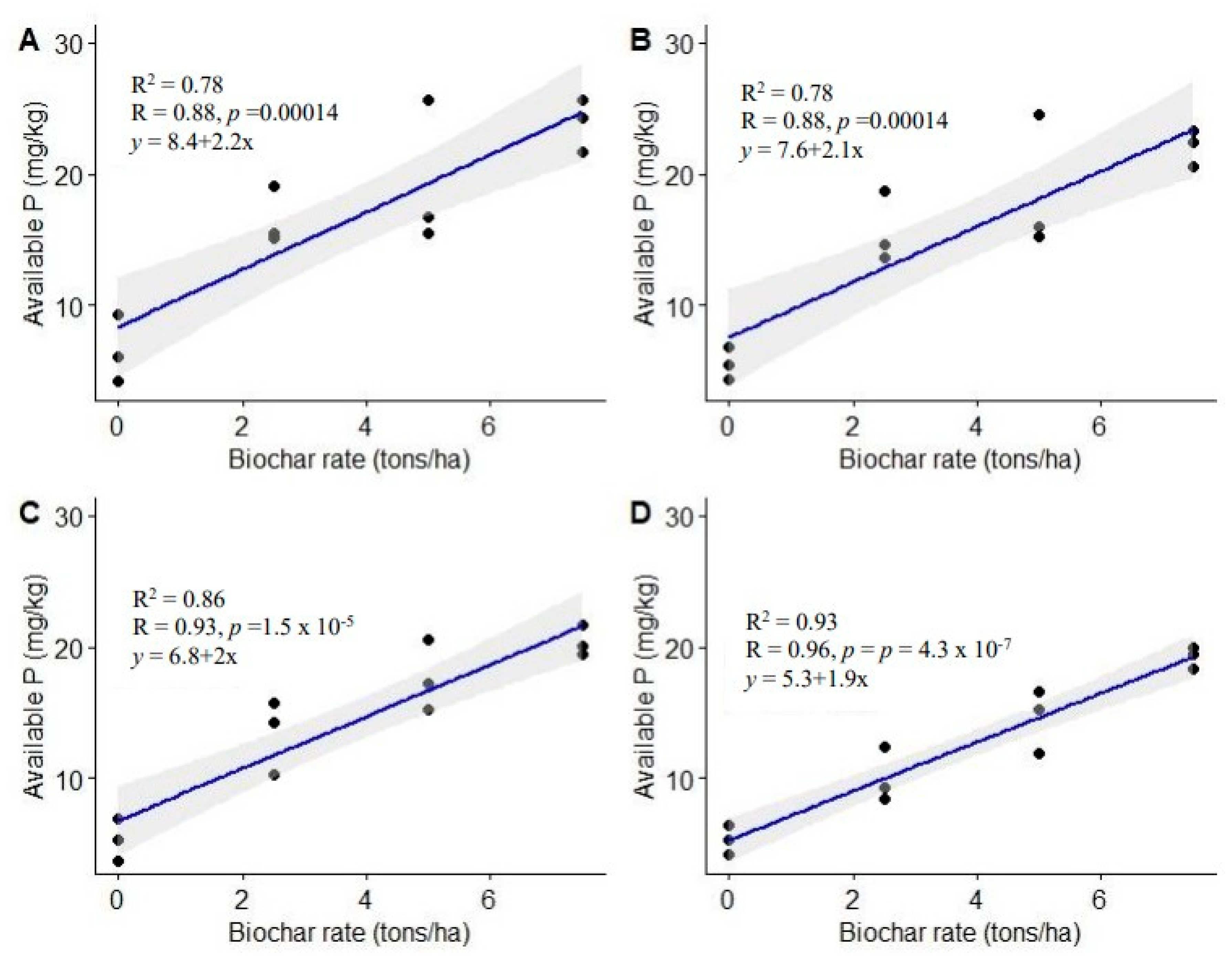
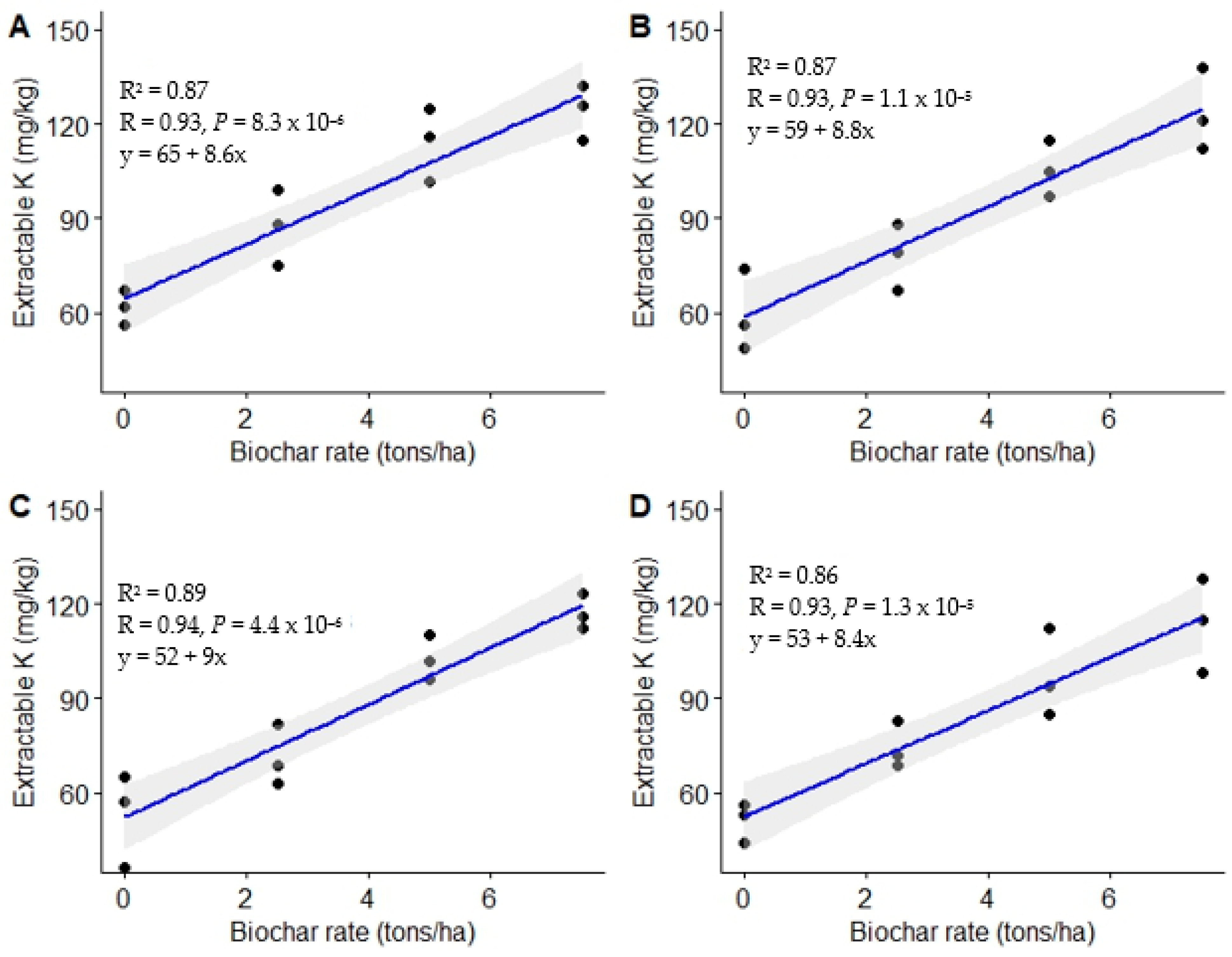
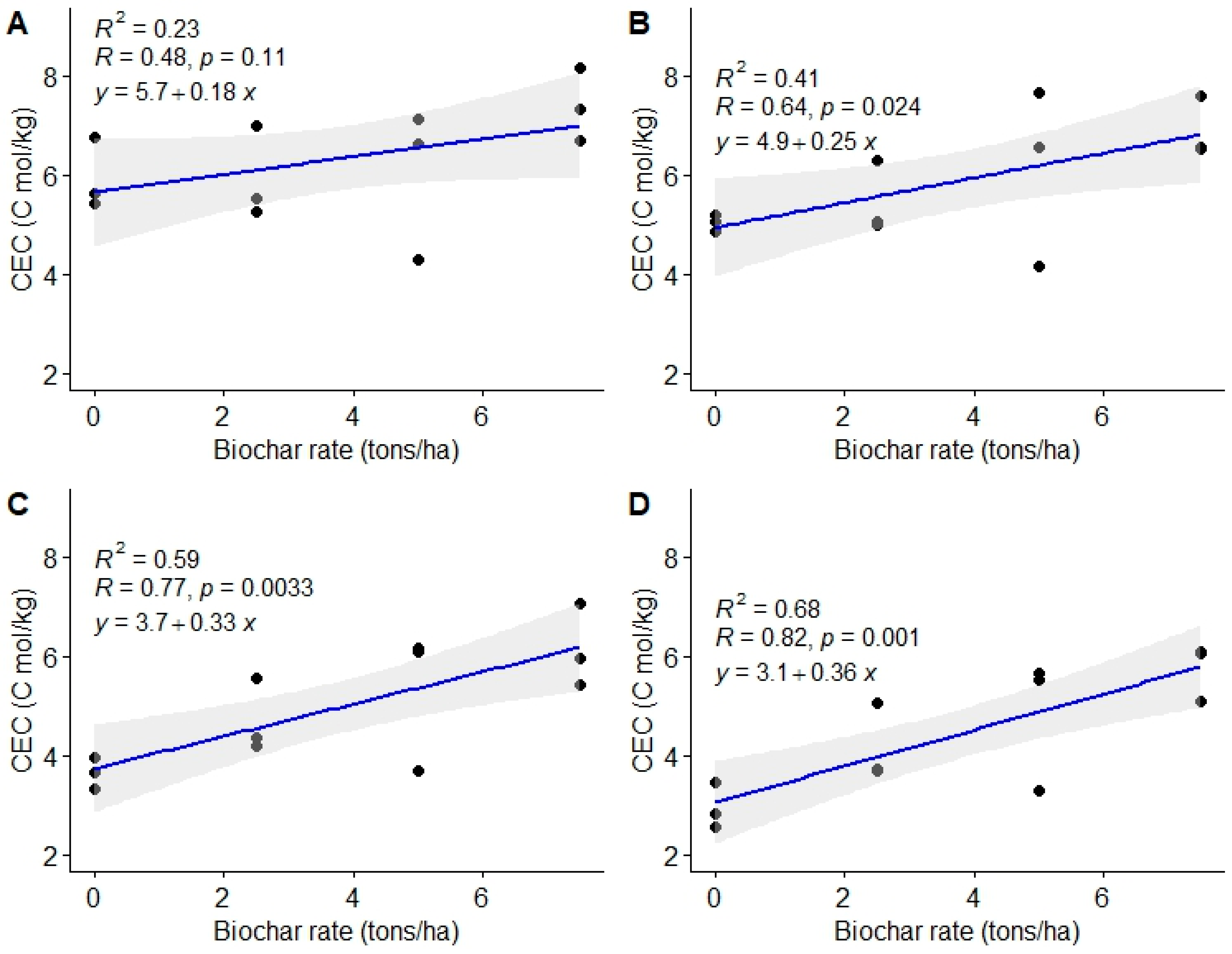
| Parameter | Site Characteristics | Biochar Characteristics |
|---|---|---|
| pH | 6.65 | 8.7 |
| EC (mS cm−1) | 0.052 | 1.39 |
| Total N (g kg−1) | 1.60 | 8.40 |
| Total organic C (g kg−1) | 3.40 | 480.0 |
| Exchangeable K (mg kg−1) | 62 | 1166.1 |
| Available P (mg kg−1) | 6.8 | 26.6 |
| Exchangeable Na (mg kg−1) | - | 989 |
| Exchangeable Ca (mg kg−1) | 200 | 746 |
| Exchangeable Mg (mg kg−1) | 149 | 354 |
| Ash (g kg−1) | - | 39.5 |
| CEC (cmol kg−1) | - | 11.2 |
| Parameter | pH ± SE | |||
|---|---|---|---|---|
| Treatments | 3 MAT | 6 MAT | 9 MAT | 12 MAT |
| B 0T | 6.50 ± 0.21 b | 6.26 ± 0.04 c | 6.33 ± 0.08 c | 6.34 ± 0.08 d |
| B 2.5T | 7.02 ± 0.33 ab | 6.85 ± 0.20 b | 6.85 ± 0.20 b | 6.87 ± 0.16 c |
| B 5.0T | 7.14 ± 0.19 a | 7.12 ± 0.20 ab | 7.27 ± 0.07 a | 7.31 ± 0.07 b |
| B 7.5T | 7.60 ± 0.50 a | 7.52 ± 0.32 a | 7.41 ± 0.06 a | 7.69 ± 0.18 a |
| f (3,8) | 5.83 | 17.83 | 50.83 | 56.38 |
| p value | 0.02 | 0.001 | 0.0001 | 0.0001 |
| Treatments | Available Phosphorus ± SE (mg kg−1) | |||
|---|---|---|---|---|
| 3 MAT | 6 MAT | 9 MAT | 12 MAT | |
| B 0T | 6.56 ± 2.54 c | 5.51 ± 1.23 c | 5.35 ± 1.58 c | 5.30 ± 1.10 d |
| B 2.5T | 16.56 ± 2.17 b | 15.67 ± 2.72 b | 13.44 ± 2.79 b | 10.05 ± 2.08 c |
| B 5.0T | 19.29 ± 5.49 ab | 18.62 ± 5.19 ab | 17.69 ± 2.70 a | 14.60 ± 2.45 b |
| B 7.5T | 23.85 ± 1.89 a | 22.13 ± 1.42 a | 20.41 ± 1.52 a | 19.27 ± 0.83 a |
| f (3,8) | 14.13 | 16.20 | 27.54 | 35.42 |
| p < 0.05 | 0.001 | 0.0009 | 0.0001 | 0.0001 |
| Treatments | Extractable Potassium ± SE (mg kg−1) | |||
|---|---|---|---|---|
| 3 MAT | 6 MAT | 9 MAT | 12 MAT | |
| B 0T | 61.7 ± 5.5 c | 59.7 ± 12.9 c | 52.7 ± 15.0 b | 51.0 ± 6.3 c |
| B 2.5T | 87.3 ± 12.0 b | 78.0 ± 10.5 b | 71.3 ± 9.7 b | 74.7 ± 7.4 b |
| B 5.0T | 114.3 ± 11.6 a | 105.7 ± 9.0 a | 102.0 ± 7.0 a | 97.0 ± 13.8 a |
| B 7.5T | 124.3 ± 8.6 a | 123.7 ± 13.2 a | 117.0 ± 5.6 a | 113.7 ± 15.0 a |
| f (3,8) | 24.93 | 18.24 | 25.71 | 17.50 |
| p < 0.05 | 0.0002 | 0.0006 | 0.0002 | 0.0007 |
| Treatments | CEC ± SE (cmol kg−1) | |||
|---|---|---|---|---|
| 3 MAT | 6 MAT | 9 MAT | 12 MAT | |
| B 0T | 5.93 ± 0.72 a | 5.03 ± 0.17 a | 3.65 ± 0.32 b | 2.95 ± 0.46 b |
| B 2.5T | 5.94 ± 0.93 a | 5.45 ± 0.74 a | 4.70 ± 0.74 ab | 4.16 ± 0.78 ab |
| B 5.0T | 6.03 ± 1.51 a | 6.13 ± 1.79 a | 5.33 ± 1.40 ab | 4.84 ± 1.33 a |
| B 7.5T | 8.17 ± 2.04 a | 7.60 ± 1.84 a | 6.15 ± 0.85 a | 5.76 ± 0.57 a |
| f (3,8) | 1.87 | 2.12 | 3.99 | 5.77 |
| p < 0.05 | 0.21 | 0.17 | 0.05 | 0.02 |
| Treatments | CFUs g Soil−1 | |||
|---|---|---|---|---|
| Bacteria × 105 | Fungi × 104 | |||
| 3 MAT | 12 MAT | 3 MAT | 12 MAT | |
| B 0T | 48 ± 4.9 b | 49 ± 4.0 b | 42 ± 8.1 c | 42 ± 8.6 b |
| B 2.5T | 54 ± 6.6 bc | 57 ± 2.6 a | 49 ± 4.0 bc | 51 ± 4.6 ab |
| B 5.0T | 59 ± 4.2 ab | 60 ± 5.5 a | 56 ± 5.5 ab | 55 ± 5.7 a |
| B 7.5T | 64 ± 4.5 a | 65 ± 6.1 a | 61 ± 4.7 a | 62 ± 4.0 a |
| f (3,8) | 5.91 | 6.64 | 6.80 | 5.58 |
| p < 0.05 | 0.02 | 0.01 | 0.01 | 0.02 |
Disclaimer/Publisher’s Note: The statements, opinions and data contained in all publications are solely those of the individual author(s) and contributor(s) and not of MDPI and/or the editor(s). MDPI and/or the editor(s) disclaim responsibility for any injury to people or property resulting from any ideas, methods, instructions or products referred to in the content. |
© 2023 by the authors. Licensee MDPI, Basel, Switzerland. This article is an open access article distributed under the terms and conditions of the Creative Commons Attribution (CC BY) license (https://creativecommons.org/licenses/by/4.0/).
Share and Cite
Alkharabsheh, H.M.; Mwadalu, R.; Mochoge, B.; Danga, B.; Raza, M.A.; Seleiman, M.F.; Khan, N.; Gitari, H. Revitalizing the Biochemical Soil Properties of Degraded Coastal Soil Using Prosopis juliflora Biochar. Life 2023, 13, 2098. https://doi.org/10.3390/life13102098
Alkharabsheh HM, Mwadalu R, Mochoge B, Danga B, Raza MA, Seleiman MF, Khan N, Gitari H. Revitalizing the Biochemical Soil Properties of Degraded Coastal Soil Using Prosopis juliflora Biochar. Life. 2023; 13(10):2098. https://doi.org/10.3390/life13102098
Chicago/Turabian StyleAlkharabsheh, Hiba M., Riziki Mwadalu, Benson Mochoge, Benjamin Danga, Muhammad Ali Raza, Mahmoud F. Seleiman, Naeem Khan, and Harun Gitari. 2023. "Revitalizing the Biochemical Soil Properties of Degraded Coastal Soil Using Prosopis juliflora Biochar" Life 13, no. 10: 2098. https://doi.org/10.3390/life13102098
APA StyleAlkharabsheh, H. M., Mwadalu, R., Mochoge, B., Danga, B., Raza, M. A., Seleiman, M. F., Khan, N., & Gitari, H. (2023). Revitalizing the Biochemical Soil Properties of Degraded Coastal Soil Using Prosopis juliflora Biochar. Life, 13(10), 2098. https://doi.org/10.3390/life13102098








